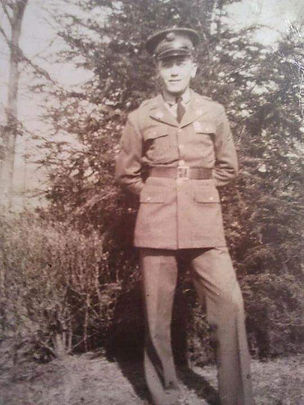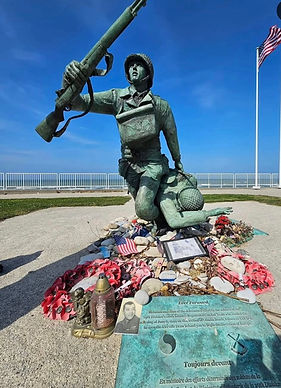
John W. Taylor,
Grandaddy and War Hero
Grandaddy Taylor was a Purple Heart Awardee, but his legacy goes beyond bravery in combat. He also taught how resilience and faith can sustain one through personal and world-wide challenges. Here is a story of his times during the Great Depression and World War Two.

Sergeant John W. Taylor,
date unknown. Photographer unknown.

Sergeant First Class (Ret) Brian Taylor with an image of his grandfather, Staff Sergeant John W. Taylor at Omaha Beach, Normandy, France. Photograph by Stacy Tayor, 2025

Monument to the 29th Infantry Division Soldiers, Omaha Beach, Normandy, France.
Photograph by Stacy Taylor, 2025
John William Taylor was a fortunate man, and he never hesitated to say so. “…I thank the Lord that he let me live through the Depression and World War II,” he told a national park interviewer in 1999.[1]
He was born in 1918, eleven years before the Great Depression hit, turning lives of millions of Americans upside down.[2] John Taylor’s family was not severely affected, however. His father was an auction overseer, which provided steady employment. On the verge of adulthood however, John could not find employment. Opportunities in the area were reserved for those without support, and since his family had support, he was overlooked when it came to hiring. “We was right fortunate,” he said, referring to those “good times.”[3]
Still, he was not deterred from finding employment of his own, and also wishing for some travel and adventure, seventeen year old John Taylor joined the Civilian Conservation Corp, a program born of Franklin Roosevelt’s New Deal, which created work programs that not only provided income to the unemployed, but improved American infrastructure.[4]
Living and working closely with groups of other men and taking orders made a natural transition to joining the army, by his own assessment.[5] With conflict around the world growing, John felt called to serve his country. “I felt it was my duty to serve my country, and I’m proud to say I did,” he said of his service to a Virginia War Memorial interviewer in October of 2000.[6] In January 1941, with American involvement in the European wars more likely, John enlisted in the Virginia National Guard. The next month their unit was activated to full-time Army by an act of Congress.[7]
The next few years were spent training for a European invasion, and John achieved the travel he yearned for. His unit trained in multiple states before journeying to England for further training. The 29th Division training was especially vigorous, training seven days per week, seldom having time off.[8] They completed challenging physical conditioning including runs and hikes of twenty to forty miles in all weather conditions. They practiced with weapons. And in the cold waters off the English coast, they stimulated the upcoming invasion.
D-Day found John Taylor ready for action. He was not afraid as he bumped along the turbulent waves of the Channel amongst incoming bombs and heavy guns. On Omaha Beach, he cleared deadly obstacles. There war became real as he witnessed many of his friends cut down. He found himself praying as he climbed a steep cliff off the beach.
John made it off the beach, as did most of his company. But that was not the end of the danger. Within the next couple of days, he put his life on the line to neutralize a heavy gun that was firing on his group, for which he earned a Silver Star. His platoon sergeant was killed. He fought through hedgerows where unseen enemies laid right beside him. As they liberated villages through France, many of his friends were killed. Several times he wondered what the use was continuing when at any moment he would be dead as well. He would never see his wife or young son again. “Why am I still here?” he asked.[9]
Physical strength, resilience, and faith kept him going. Months of intense training made him physically strong enough to withstand the demands of combat over challenging terrains. He battled dark thoughts, knowing he had to fight them, and learned that “you wasn’t going to win the war by yourself…or in a day; you had friends to help you.”[10] And he relied on faith. “The Lord, I knew, had to be with me,” he often remarked.[11] Reflecting on his experiences years later, he was filled with gratitude. “I thank the Lord that he gave me life to live through the Great Depression and be able to serve in WWII.”[12]
Balkoski, Joseph. Beyond the Beachhead. Stackpole books. 1999.
Ewing, Joseph H. Twenty-Nine, Let’s Go: A History of the 20th Infantry Division in World War II. First. Infantry Journal Press, 1948.
Fold3. “John W Taylor in US, WWII Army Enlistment Records, 1938-1946.” 2025. https://www.fold3.com/record/85216919/john-w-taylor-us-wwii-army-enlistment-records-1938-1946.
John W. Taylor, Virginia War Memorial Video. Performed by John W. Taylor. Charlottesville, VA, 2000. Video. The Virginia War Memorial’s Oral History Project. https://virginiagov.app.box.com/s/3g98y1noa82lobq0i9kfinl2v8fkzczz.
Richardson, Gary. “The Great Depression.” Federal Reserve History, November 22, 1013. https://www.federalreservehistory.org/essays/great-depression.
Taylor, John W. “Oral History Interview with John Taylor.” Interview by John Amberson. September 25, 1999. Shenandoah National Park. https://www.nps.gov/shen/learn/historyculture/upload/ccc_oral_history_john_taylor.pdf.
“The Civilian Conservation Corps.” National Park Service, May 5, 2025. https://www.nps.gov/articles/the-civilian-conservation-corps.htm.
[1] John W. Taylor, “Oral History Interview with John Taylor,” interview by John Amberson, September 25, 1999, Shenandoah National Park, 3.
[2] Gary Richardson, “The Great Depression,” Federal Reserve History, November 22, 1013.
[3] Taylor, “Oral History Interview with John Taylor,” 3.
[4] “The Civilian Conservation Corps,” National Park Service, May 5, 2025.
[5] Taylor, “Oral History Interview with John Taylor,” 4.
[6] John W. Taylor, Virginia War Memorial Video, performed by John W. Taylor, Charlottesville, VA, 2000, Video, The Virginia War Memorial’s Oral History Project.
[7] “John W Taylor in US, WWII Army Enlistment Records, 1938-1946,” Fold3, 2025,; Joseph H. Ewing, Twenty-Nine, Let’s Go: A History of the 20th Infantry Division in World War II, First (Infantry Journal Press, 1948).
[8] Joseph Balkoski, Beyond the Beachhead (1999).
[9] John W. Taylor, Virginia War Memorial Video.
[10] Ibid.
[11] Ibid.
[12] Ibid.

Roadside Memorial to 2nd Lt. Ralph Ferguson of the 116th Infantry, 29th Division.
Killed in action at this location while securing a bridge on the journey from Normandy to Saint-Lo, France. Photograph by Stacy Taylor, 2025.

John W. Taylor,
date and photographer unknown.